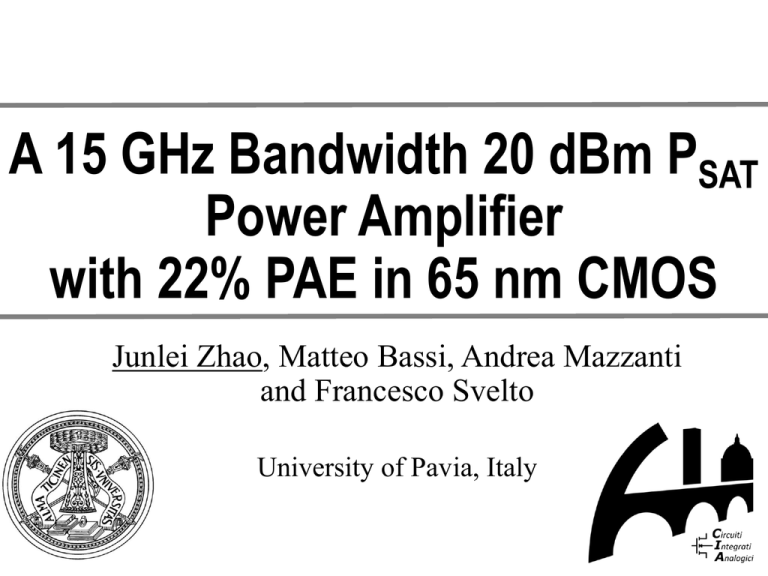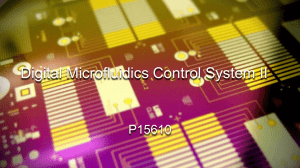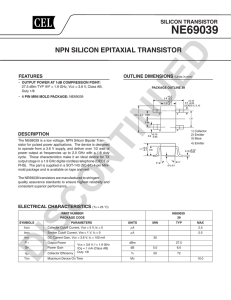A 15 GHz Bandwidth 20 dBm P Power Amplifier with 22% PAE in 65
advertisement

A 15 GHz Bandwidth 20 dBm PSAT Power Amplifier with 22% PAE in 65 nm CMOS Junlei Zhao, Matteo Bassi, Andrea Mazzanti and Francesco Svelto University of Pavia, Italy Outline • Wideband Power Amplifier Design Challenges • Coupled Resonators to Improve GBW • Wideband Power Combining/Splitting • Circuit Design and Measurement • Conclusions Zhao et al., A 15 GHz-Bandwidth 20 dBm PSAT Power Amplifier with 22% PAE in 65 nm CMOS 2 Wideband Power Amplifier Design Challenges • High efficiency requires high gain POut PIn POut 1 PAE 1 PDC PDC G • Bandwidth trades with gain and efficiency • Improving GBW is the key to achieve high efficiency over large bandwidth Zhao et al., A 15 GHz-Bandwidth 20 dBm PSAT Power Amplifier with 22% PAE in 65 nm CMOS 3 GBW of Power Amplifiers • Active devices • Maximum gain is limited by technology • Class AB biasing further reduces gain • Large layouts determine significant parasitics • Passive matching networks • High-order networks can enhance GBW • Compact layout to minimize loss Zhao et al., A 15 GHz-Bandwidth 20 dBm PSAT Power Amplifier with 22% PAE in 65 nm CMOS 4 Outline • Wideband Power Amplifier Design Challenges • Coupled Resonators to Improve GBW • Wideband Power Combining/Splitting • Circuit Design and Measurement • Conclusions Zhao et al., A 15 GHz-Bandwidth 20 dBm PSAT Power Amplifier with 22% PAE in 65 nm CMOS 5 Coupled Resonators • Simple topology and low loss • Two peaking frequencies: L 1 L , H 1 2 L LC LC • LC used to control the bandwidth Zhao et al., A 15 GHz-Bandwidth 20 dBm PSAT Power Amplifier with 22% PAE in 65 nm CMOS 6 GBW Enhancement 50 CR LC |Zt| [dBOhm] 45 40 35 30 25 20 15 20 40 60 80 Frequency [GHz] 100 ZtCR 2 Zt LC , BWCR 2 BWLC Coupled resonators allow 2x GBW enhancement (GBWEN) Zhao et al., A 15 GHz-Bandwidth 20 dBm PSAT Power Amplifier with 22% PAE in 65 nm CMOS 7 Transformation of Coupled Resonators Split Lc Norton transformation Transformer n 1 GBWEN 2 n Zhao et al., A 15 GHz-Bandwidth 20 dBm PSAT Power Amplifier with 22% PAE in 65 nm CMOS 8 Effect of Layout Parasitics 50 |Zt| [dBOhm] 40 30 20 Decreasing Q 10 Q=100 0 30 40 Q=30 50 60 70 Frequency [GHz] Q=10 80 90 • Limited inductor Q leads to asymmetric response • Network needs to be smart to accommodate parasitics Zhao et al., A 15 GHz-Bandwidth 20 dBm PSAT Power Amplifier with 22% PAE in 65 nm CMOS 9 Restoring Flat Response 35 |Zt| [dBOhm] 30 ZT (H ) L1 ZT (L ) L3 25 Increasing L1/L3 20 15 10 5 30 Q=10 40 50 60 70 Frequency [GHz] 80 90 • Coupled resonator can be conveniently tuned to achieve flat response Zhao et al., A 15 GHz-Bandwidth 20 dBm PSAT Power Amplifier with 22% PAE in 65 nm CMOS 10 Outline • Wideband Power Amplifier Design Challenges • Coupled Resonators to Improve GBW • Wideband Power Combining/Splitting • Circuit Design and Measurement • Conclusions Zhao et al., A 15 GHz-Bandwidth 20 dBm PSAT Power Amplifier with 22% PAE in 65 nm CMOS 11 Power Combing • Power combining is mandatory to achieve high Pout for CMOS PAs • Transformer based combiner/splitter is popular • Compact size • Low insertion loss • Generally narrow bandwidth Wideband combining through coupled resonators Zhao et al., A 15 GHz-Bandwidth 20 dBm PSAT Power Amplifier with 22% PAE in 65 nm CMOS 12 Wideband Combiner 2x 4x 2x • Easy to transform • Divide the left network into two equal portions Zhao et al., A 15 GHz-Bandwidth 20 dBm PSAT Power Amplifier with 22% PAE in 65 nm CMOS 13 Wideband Splitter • Easy to transform • Divide the right network into two equal portions Zhao et al., A 15 GHz-Bandwidth 20 dBm PSAT Power Amplifier with 22% PAE in 65 nm CMOS 14 Comparison with Transformer Splitter 40 |Zt| [dBOhm] 35 30 25 20 15 (a) transformer based splitter 10 20 Proposed Splitter Transformer based Splitter 40 60 80 Frequency [GHz] 100 More than two times GBW enhancement. (b) proposed splitter Zhao et al., A 15 GHz-Bandwidth 20 dBm PSAT Power Amplifier with 22% PAE in 65 nm CMOS 15 Outline • Wideband Power Amplifier Design Challenges • Coupled Resonators to Improve GBW • Wideband Power Combining/Splitting • Circuit Design and Measurement • Conclusions Zhao et al., A 15 GHz-Bandwidth 20 dBm PSAT Power Amplifier with 22% PAE in 65 nm CMOS 16 PA Design • A prototype has been designed in ST 65nm CMOS • • • • Bandwidth >13 GHz Gain > 25dB P1dB > 15dBm PAE > 20% 120u/60n 120u/60n 240u/60n 120u/60n 240u/60n Zhao et al., A 15 GHz-Bandwidth 20 dBm PSAT Power Amplifier with 22% PAE in 65 nm CMOS 17 Layout of Splitter a b (a) splitter network (b) 1st topology (c) 2nd topology • Two different layout topologies for splitter Zhao et al., A 15 GHz-Bandwidth 20 dBm PSAT Power Amplifier with 22% PAE in 65 nm CMOS 18 Stability Analysis (a) 1st topology (b) 2nd topology • Proposed splitter can suppress differential-mode common-mode oscillation Zhao et al., A 15 GHz-Bandwidth 20 dBm PSAT Power Amplifier with 22% PAE in 65 nm CMOS 19 Chip Photomicrograph ST 65nm CMOS Chip area: 0.57 mm2 Core area: 0.11 mm2 Zhao et al., A 15 GHz-Bandwidth 20 dBm PSAT Power Amplifier with 22% PAE in 65 nm CMOS 20 Measured S-Parameters S-Parameters [dB] 40 20 0 -20 S21 S12 S11 S22 -40 -60 40 50 60 70 80 Frequency [GHz] 90 Gain≈30dB, BW3dB: 58.5-73.5GHz Zhao et al., A 15 GHz-Bandwidth 20 dBm PSAT Power Amplifier with 22% PAE in 65 nm CMOS 21 Pout [dBm] / Gain [dB] / PAE [%] Large Signal Performances at 65GHz 35 Pout Gain PAE 30 25 20 15 10 5 0 -20 -15 -10 -5 0 Input Power [dBm] 5 PSAT≈20dBm, P1dB≈16dBm, PAE≈22% Zhao et al., A 15 GHz-Bandwidth 20 dBm PSAT Power Amplifier with 22% PAE in 65 nm CMOS 22 Pout [dBm] / P1dB [dBm] / PAE [%] Large Signal Performances over Frequency 25 Peak PAE Pout P1dB 22 19 16 13 10 55 60 65 Frequency [GHz] 70 75 PSat>19dBm, P1dB>15dBm, PAE>15% over the bandwidth Zhao et al., A 15 GHz-Bandwidth 20 dBm PSAT Power Amplifier with 22% PAE in 65 nm CMOS 23 Performance Summary and Comparison Reference Tech. & Vdd CICC13 [5] 28nm / 1V 24 11 174 16.5 11.7 13 JSSC13 [3] 40nm / 1V 17 6 42 17 13.8 30 RFIC14 [2] 65nm / 1.2V 17.7 12 92 16.8 15.5 15 ISSCC14 [8] 40nm / 1.8V 22.4 n/a n/a 16.4 13.9 19 ISSCC15 [1] 28nm SOI/ 1V 35 8 450 18.9 15 18 30 15 474 20 16 22 This Work 65nm / 1V Gain BW GBW PSAT P1dB PAE (dB) (GHz) (GHz) (dBm) (dBm) (%) State-of-the-art PSAT and PAE with the largest GBW Zhao et al., A 15 GHz-Bandwidth 20 dBm PSAT Power Amplifier with 22% PAE in 65 nm CMOS 24 Conclusions • High GBW is critical for high efficient, wideband PAs • Coupled resonators can improve PA GBW while keeping compact layout • A methodology has been proposed to design wideband combiner/splitter using coupled resonators • A three-stage two-path PA with 20dBm PSAT, 22% PAE, and 15GHz bandwidth in 65nm CMOS was demonstrated Zhao et al., A 15 GHz-Bandwidth 20 dBm PSAT Power Amplifier with 22% PAE in 65 nm CMOS 25 Acknowledgements • Studio di Microelecttronica, Pavia, Italy • Prof. Yann Deval and Magali de Matos, University of Bordeaux Zhao et al., A 15 GHz-Bandwidth 20 dBm PSAT Power Amplifier with 22% PAE in 65 nm CMOS 26 Thank You! References [1] A. Larie et al., “A 60 GHz 28 nm UTBB FD-SOI CMOS reconfigurable power amplifier with 21% PAE, 18.2 dBm P1dB and 74mW PDC,” in ISSCC15 [2] P. Farahabadi and K. Moez, “A dual-mode highly efficient 60 GHz power amplifier in 65 nm CMOS,” in RFIC14 [3] D. Zhao and P. Reynaert, “A 60-GHz dual-mode class AB power amplifier in 40-nm CMOS,” in JSSC13 [4] K.-Y. Wang, T.-Y. Chang, and C.-K. Wang, “A 1V 19.3dbm 79GHz power amplifier in 65nm CMOS,” in ISSCC12 [5] S. Thyagarajan, A. Niknejad, and C. Hull, “A 60 GHz linear wideband power amplifier using cascode neutralization in 28 nm CMOS,” in CICC13 [8] S. Kulkarni and P. Reynaert, “A Push-Pull mm-Wave Power Amplifier with <0.8° AM-PM Distortion in 40nm CMOS,” in ISSCC14 Zhao et al., A 15 GHz-Bandwidth 20 dBm PSAT Power Amplifier with 22% PAE in 65 nm CMOS 28

